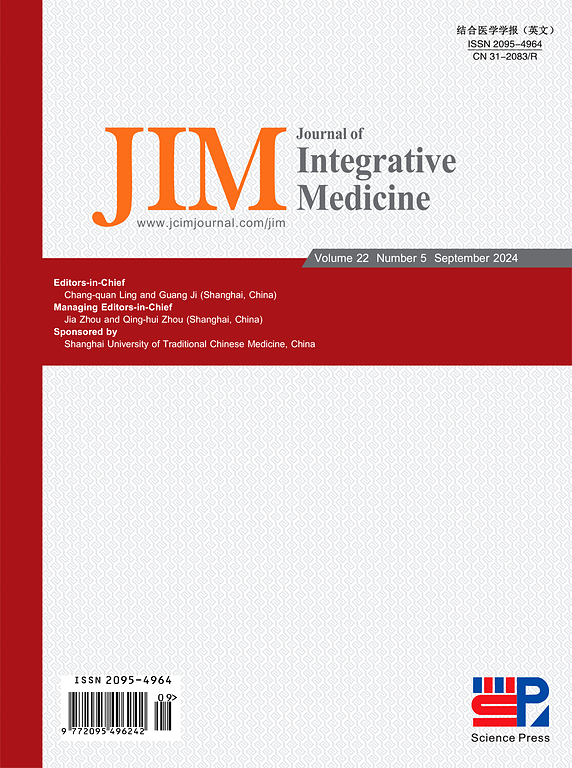夏枯草多糖对非酒精性脂肪性肝炎和肠道失调的治疗作用。
IF 4
2区 医学
Q1 INTEGRATIVE & COMPLEMENTARY MEDICINE
引用次数: 0
摘要
目的:根据中医理论,夏枯草早就被用于保肝,并被现代药理学研究证实具有多种潜在的保肝作用。然而,其对非酒精性脂肪性肝炎(NASH)的影响目前尚不确定。我们的研究探讨了凡草多糖对NASH和肠道内稳态的影响。方法:采用85%乙醇溶液(PVE85)沉淀法提取凡士林干果穗水提物,提取其粗多糖。采用胆碱缺乏、l -氨基酸限定的高脂肪饮食(CDAHFD)喂养雄性C57BL/6小鼠,建立NASH动物模型。4周后,PVE85组口服PVE85 (200 mg/[kg·d]),对照组和CDAHFD组口服载药6周。采用实时定量聚合酶链反应分析、Western blotting、免疫组织化学等方法评估PVE85对NASH小鼠肝脏的影响。采用16S rRNA基因扩增子分析评估各组肠道菌群丰度和多样性,以检测不同分类水平上的变化。结果:PVE85显著逆转小鼠NASH病程。PVE85治疗后,与NASH相关的炎症介质mRNA水平和肝脏核苷酸结合富亮氨酸重复序列和pyrin结构域蛋白3 (NLRP3)的蛋白表达显著降低。此外,PVE85减弱了NASH小鼠肝脏中胶原纤维的增厚和交联,并抑制了纤维化相关mrna的表达。有趣的是,PVE85通过在门水平上增加放线菌的丰度和减少变形菌的丰度,恢复了肠道微生物群的变化,改善了NASH诱导的肠道屏障功能障碍。PVE85在科水平上具有显著的降低梭菌科相对丰度的活性。PVE85在不同分类水平上也显著提高了一些有益微生物的丰度。此外,肠道的理化环境得到有效改善,包括肠绒毛密度增加,肠道pH值正常化,肠道通透性改善。结论:PVE85可减轻cdahfd诱导的NASH动物模型肝脏脂质过度积累、炎症和纤维化,改善肠道微生物组成和肠道结构。本文署名:朱俊杰,宋玉军,饶普乐,顾伟,徐勇,徐海霞。夏枯草多糖对非酒精性脂肪性肝炎和肠道失调的治疗作用。集成医学[J];打印前Epub。本文章由计算机程序翻译,如有差异,请以英文原文为准。
Therapeutic role of Prunella vulgaris L. polysaccharides in non-alcoholic steatohepatitis and gut dysbiosis
Objective
Prunella vulgaris L. has long been used for liver protection according to traditional Chinese medicine theory and has been proven by modern pharmacological research to have multiple potential liver-protective effects. However, its effects on non-alcoholic steatohepatitis (NASH) are currently uncertain. Our study explores the effects of P. vulgaris polysaccharides on NASH and intestinal homeostasis.
Methods
An aqueous extract of the dried fruit spikes of P. vulgaris was precipitated in an 85% ethanol solution (PVE85) to extract crude polysaccharides from the herb. A choline-deficient, L-amino acid-defined, high-fat diet (CDAHFD) was administrated to male C57BL/6 mice to establish a NASH animal model. After 4 weeks, the PVE85 group was orally administered PVE85 (200 mg/[kg·d]), while the control group and CDAHFD group were orally administered vehicle for 6 weeks. Quantitative real-time polymerase chain reaction analysis, Western blotting, immunohistochemistry and other methods were used to assess the impact of PVE85 on the liver in mice with NASH. 16S rRNA gene amplicon analysis was employed to evaluate the gut microbiota abundance and diversity in each group to examine alterations at various taxonomic levels.
Results
PVE85 significantly reversed the course of NASH in mice. mRNA levels of inflammatory mediators associated with NASH and protein expression of hepatic nucleotide-binding leucine-rich repeat and pyrin domain-containing protein 3 (NLRP3) were significantly reduced after PVE85 treatment. Moreover, PVE85 attenuated the thickening and cross-linking of collagen fibres and inhibited the expression of fibrosis-related mRNAs in the livers of NASH mice. Intriguingly, PVE85 restored changes in the gut microbiota and improved intestinal barrier dysfunction induced by NASH by increasing the abundance of Actinobacteria and reducing the abundance of Proteobacteria at the phylum level. PVE85 had significant activity in reducing the relative abundance of Clostridiaceae at the family levels. PVE85 markedly enhanced the abundance of some beneficial micro-organisms at various taxonomic levels as well. Additionally, the physicochemical environment of the intestine was effectively improved, involving an increase in the density of intestinal villi, normalization of the intestinal pH, and improvement of intestinal permeability.
Conclusion
PVE85 can reduce hepatic lipid overaccumulation, inflammation, and fibrosis in an animal model of CDAHFD-induced NASH and improve the intestinal microbial composition and intestinal structure.
Please cite this article as: Zhu MJ, Song YJ, Rao PL, Gu WY, Xu Y, Xu HX. Therapeutic role of Prunella vulgaris L. polysaccharides in non-alcoholic steatohepatitis and gut dysbiosis. J Integr Med. 2025; 2025; 23(3): 297–308.
求助全文
通过发布文献求助,成功后即可免费获取论文全文。
去求助
来源期刊

Journal of Integrative Medicine-Jim
Medicine-Complementary and Alternative Medicine
CiteScore
9.20
自引率
4.20%
发文量
3319
期刊介绍:
The predecessor of JIM is the Journal of Chinese Integrative Medicine (Zhong Xi Yi Jie He Xue Bao). With this new, English-language publication, we are committed to make JIM an international platform for publishing high-quality papers on complementary and alternative medicine (CAM) and an open forum in which the different professions and international scholarly communities can exchange views, share research and their clinical experience, discuss CAM education, and confer about issues and problems in our various disciplines and in CAM as a whole in order to promote integrative medicine.
JIM is indexed/abstracted in: MEDLINE/PubMed, ScienceDirect, Emerging Sources Citation Index (ESCI), Scopus, Embase, Chemical Abstracts (CA), CAB Abstracts, EBSCO, WPRIM, JST China, Chinese Science Citation Database (CSCD), and China National Knowledge Infrastructure (CNKI).
JIM Editorial Office uses ThomsonReuters ScholarOne Manuscripts as submitting and review system (submission link: http://mc03.manuscriptcentral.com/jcim-en).
JIM is published bimonthly. Manuscripts submitted to JIM should be written in English. Article types include but are not limited to randomized controlled and pragmatic trials, translational and patient-centered effectiveness outcome studies, case series and reports, clinical trial protocols, preclinical and basic science studies, systematic reviews and meta-analyses, papers on methodology and CAM history or education, conference proceedings, editorials, commentaries, short communications, book reviews, and letters to the editor.
Our purpose is to publish a prestigious international journal for studies in integrative medicine. To achieve this aim, we seek to publish high-quality papers on any aspects of integrative medicine, such as acupuncture and traditional Chinese medicine, Ayurveda medicine, herbal medicine, homeopathy, nutrition, chiropractic, mind-body medicine, taichi, qigong, meditation, and any other modalities of CAM; our commitment to international scope ensures that research and progress from all regions of the world are widely covered. These ensure that articles published in JIM have the maximum exposure to the international scholarly community.
JIM can help its authors let their papers reach the widest possible range of readers, and let all those who share an interest in their research field be concerned with their study.
 求助内容:
求助内容: 应助结果提醒方式:
应助结果提醒方式:


